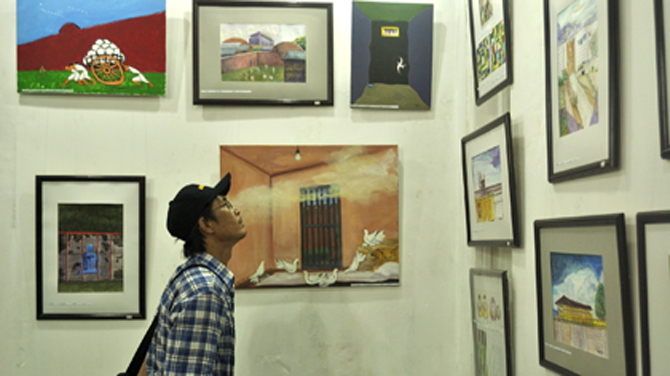Rangoon Art Show Provides Arresting Display

RANGOON—Unlike any other exhibition, the Amnesty Prison Art Show 2012 has something different for the viewing public—a remarkable collection of clandestine works made during incarceration by ex-political prisoners.
Organized by the Former Political Prisoners Group, the exhibition held in Rangoon from March 9 to 15 presents a rare chance for these pictures to see the light of day for the first time.
 |
The exhibition boasts 110 paintings by 36 ex-political prisoners, including works by the 1988 student leaders Min Ko Naing, Htay Kywe , Jimmy and Pyone Cho. The oldest artist is now over 70 while the youngest are in their late 20s.
“We also want to raise public awareness regarding the fact that despite the president's latest amnesty, there are some political dissidents still locked in prisons,” said organizing team member Tun Win Nyein.
He added that any profit generated from the show will go to the welfare of political prisoners who are still behind bars and other charity services.
The works created during jail terms were the results of using myriad different mediums—pencils, ink, pastels, watercolors, oil paints, cotton threads and even colorful plastic bags—revealing conditions where inmates had to rely on any material within their reach to express their creativity.
Infamous for their brutal oppression of prisoners' rights, Burmese jails are far from a perfect studio for inmates to turn into artists. To simply kill time during their detention, some merely resumed their childhood hobby while others honed artistic skills acquired before their imprisonments.
A number of painters interviewed by The Irrawaddy said they were not even allowed to use a sheet of blank paper to make drawings during the 1990s. Brushes, pastels or watercolor paints were out of question at the time.
“In those days if you were caught with even a very small piece of newspaper cutting from a cheroot butt in hand, you would be severely beaten,” said Tun Win Nyein, an artist who spent nine years in prison for political activities.
Min Ko Naing recalled how he drew on the wall of his prison cell before eventually gaining access to canvas and paints in 2010.
“I used a spike or piece of charcoal or even smashed bricks, anything available, to draw pictures on the wall,” he said.
The old saying “where there's a will, there's a way” seems particularly true for artists behind bars with burning creativity.
"I used discarded colored plastic bags to make collages because there's nothing else available to make paintings,” said San Zaw Htew, a political dissident released from Taungoo Prison in January.
His sophisticated collages of a peacock and a portrait sketch of the Burmese democracy leader Aung San Suu kyi drew great attention and praise from visitors at the exhibition. “It took me a few months to finish them,” he explains. “I did them in secret lest they were confiscated by the prison authorities.”
Another ex-political prisoner, Hlaing Win Swe, 37, said he did abstract illustrations in ink with an illicit ballpoint pen on any free space in magazines smuggled into his cell. He was incarcerated in Myaungmya Prison until his release in January.
But how much inmates could create depended solely on the prison authorities and how strictly they enforced regulations. Tun Win Nyein said some jails started to lift restrictions on political prisoners around 2008, but there was no consistency.
“In some prisons, political prisoners were allowed to read but not write as the jailers considered it to be a threat to prison security,” he said. “But both were OK in other prisons. If you are lucky enough to be in that kind of jail, you could do painting if you wished.”
Jimmy, one of the 88 Students Group leaders, said that later in his sentence his family could send drawing materials to him in Taunggyi Prison where he spent four years.
1 | 2 next page »
|
||
|
||
- Students Without a University
- Displaced and Distressed
- Training the Next Generation of Kachin Rebels
- Magical Mandalay Still Holds Court for Tourists
- Distrust and Displacement on Kachin Frontline
- Thein Sein: Reformist or Caretaker?
- School’s Not Out in Kachin State
- Irrawaddy Dolphins are Firm Fisherman’s Friends
- Thein Sein: Reformist or Caretaker?
- For Rangoon Strikers, No End in Sight
